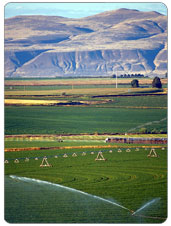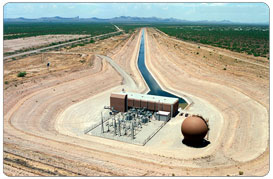Bureau of Reclamation
Water Conservation Field Services Program
 The U.S. Bureau of Reclamation has a major responsibility, in partnership with water users, States, and other interested parties, to help improve water resource management and the efficiency of water use in the western United States. With passage of the Reclamation Act of 1902 , Reclamation's original challenge was to promote the settlement of the West by providing the necessary infrastructure for the irrigation of small family farms. Extensive tracts of arid and semi-arid lands have become some of the most productive agricultural area and urban centers in the world. And, in addition to irrigation, Reclamation projects provide water for homes and industries, recreation, fish and wildlife, power generation, and flood control. Now, after more than 100 years, Reclamation's primary role has evolved from one of water resource development to one of water resource management. More efficient water use is a key component of Reclamation's water resource management strategy.
The U.S. Bureau of Reclamation has a major responsibility, in partnership with water users, States, and other interested parties, to help improve water resource management and the efficiency of water use in the western United States. With passage of the Reclamation Act of 1902 , Reclamation's original challenge was to promote the settlement of the West by providing the necessary infrastructure for the irrigation of small family farms. Extensive tracts of arid and semi-arid lands have become some of the most productive agricultural area and urban centers in the world. And, in addition to irrigation, Reclamation projects provide water for homes and industries, recreation, fish and wildlife, power generation, and flood control. Now, after more than 100 years, Reclamation's primary role has evolved from one of water resource development to one of water resource management. More efficient water use is a key component of Reclamation's water resource management strategy.
Reclamation recognizes that no single entity, acting independently can meet the challenge of improving the efficiency of water use and management throughout the western States. Consequently, a key to meeting this challenge will be the partnerships formed between Reclamation and water users, other Federal and State agencies, educational and research institutions, and other interested parties.
Developing a thorough water conservation plan is an opportunity for every water user to identify water management problems, evaluate options, highlight accomplishments, and plan for improvements.
 |
Conservation measures can:
|
Most Western lands typically receive far less annual precipitation than that received by Eastern and Southern states. Early Western settlers quickly discovered that survival in this area was extremely difficult because rainfall was neither plentiful nor reliable. The transformation of this dry, barren desert region into productive farmland, and thriving towns and cities began with the construction of facilities to store and transport water.
Today, the many benefits of controlling water in this way are evident in the extensive development that has taken place throughout the West over the past 100 years. Huge cities have been created and millions of people live, work, and recreate in this desert region. But, as the West continues to grow, we must face the problem of continually increasing demands on a finite supply of water. This includes human population needs and the needs of the environment.
 Unless highly efficient water usage practices can be developed and maintained in the West, it will not be possible to provide the water needed to sustain western ecosystems as well as economic and population growth. So how will these increasing and diverse needs be met? By each one of us doing what we can to use water wisely. The responsibility to protect and conserve this vital resource to ensure that a sufficient water supply will continue to exist rests with us all.
Unless highly efficient water usage practices can be developed and maintained in the West, it will not be possible to provide the water needed to sustain western ecosystems as well as economic and population growth. So how will these increasing and diverse needs be met? By each one of us doing what we can to use water wisely. The responsibility to protect and conserve this vital resource to ensure that a sufficient water supply will continue to exist rests with us all.
As the agency created to design and build many of this nation's water projects, and as the largest water wholesaler in the country, water conservation is one of the Bureau of Reclamation's top priorities. Reclamation has undertaken a series of conservation initiatives designed to stretch our water supply to meet additional needs. We believe with the help of water users throughout the West, more efficient water use by everyone will help meet much of the increasing demand for water. In addition, these efforts will result in several other benefits including: reduced costs to the federal government and water users; improved reliability of existing water supplies; reduced drought impacts; improved and protected surface and groundwater quality through the reduction of non-point and point sources of pollution; and energy conservation.
Last Updated: 6/19/08

